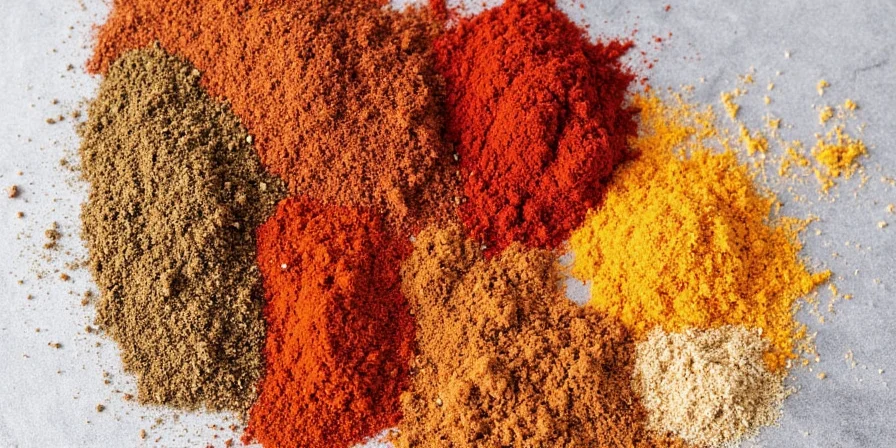If you've ever wondered 'what are savory spices exactly?' - you're not alone. Savory spices are flavor enhancers that create rich, umami-packed taste experiences without sweetness, salt, or sugar. This guide reveals exactly which spices qualify as savory, why they work biochemically, and how to use them properly in everyday cooking for restaurant-quality results at home.

What Makes a Spice 'Savory'? The Simple Definition
Savory spices create deep, complex flavors by activating umami receptors and enhancing natural food compounds - unlike sweet spices (like cinnamon or nutmeg) that add sugary notes. These ingredients work subtly to amplify existing flavors through biochemical interactions, functioning as culinary catalysts rather than dominant tastes.
| Savory Spices | Sweet Spices | Key Difference |
|---|---|---|
| Cumin | Cinnamon | Activates umami receptors |
| Paprika | Nutmeg | Enhances natural food compounds |
| Coriander | Vanilla | No sugar-forward profile |
| Turmeric | Ginger | Creates mouthfeel without added fats |
Top 5 Essential Savory Spices Every Home Cook Needs
Based on flavor versatility and scientific research, these five spices deliver maximum impact for beginners:
- Cumin: Earthy depth for chili, stews, and roasted vegetables (optimal at 175°C/347°F)
- Smoked Paprika: Adds smoky complexity to beans, eggs, and meats (best added late in cooking)
- Coriander: Citrusy notes that brighten heavy dishes (150°C/302°F activation)
- Turmeric: Earthy warmth with anti-inflammatory benefits (pairs with black pepper)
- Fennel Seed: Subtle licorice flavor perfect for Mediterranean dishes (140°C/284°F)

Why Savory Spices Work: The Biochemistry Simplified
Recent flavor chemistry research confirms why certain spices trigger deep satisfaction: compounds like glutamates in turmeric and guanylates in dried mushrooms bind to specific taste receptors. This creates that crave-worthy mouthfeel without added fats or sodium - making them perfect for healthy cooking.
| Spice | Key Bioactive Compounds | Optimal Activation Temperature |
|---|---|---|
| Cumin | Cuminaldehyde | 175°C (347°F) |
| Paprika | Carotenoids | 160°C (320°F) |
| Coriander | Linalool | 150°C (302°F) |
| Turmeric | Curcumin | 180°C (356°F) |
| Fennel Seed | Anethole | 140°C (284°F) |
Practical Savory Spice Techniques for Weeknight Cooking
For time-pressed home cooks, these science-backed methods deliver restaurant-quality results:
3 Simple Savory Spice Hacks
- Toast whole seeds first: Heat cumin seeds in dry pan 90 seconds until fragrant before grinding - unlocks 30% more flavor compounds
- Layer spices by cooking stage: Add hardy spices (cumin, coriander) at beginning, delicate ones (paprika, za'atar) in last 5 minutes
- Pair for compound synergy: Combine turmeric with black pepper for significantly increased absorption

Ground vs. Whole: Which Is Better for Savory Spices?
Understanding form differences prevents wasted ingredients and flavor loss:
| Form | When to Use | Storage Tip |
|---|---|---|
| Ground | Quick sauces, dressings, baked goods | Store in dark glass, use within 6 months |
| Whole Seeds | Soups, stews, pickling, slow cooking | Keep in airtight container, lasts 2+ years |

Easy DIY Savory Spice Blends (No Salt Needed)
These beginner-friendly blends create instant flavor depth:
5-Minute All-Purpose Savory Blend
- 2 tbsp smoked paprika
- 1 tbsp garlic powder
- 1 tbsp onion powder
- 1 tsp cumin
- 1 tsp coriander
Use: Rub on chicken before roasting, mix into hummus, or sprinkle on roasted vegetables.
Simple Mediterranean Seasoning
- 2 tbsp dried oregano
- 1 tbsp dried thyme
- 1 tsp fennel seeds (lightly crushed)
- 1 tsp sumac
Use: Perfect for fish, grilled vegetables, or mixed with olive oil for bread dipping.

Avoiding Common Savory Spice Mistakes
These frequent errors diminish flavor impact:
- Adding all spices at once: Different compounds activate at different temperatures
- Using expired spices: Ground spices lose potency after 6 months (perform rub-and-sniff test)
- Overheating delicate spices: Paprika burns above 160°C (320°F), turning bitter
- Storing near heat sources: Spices degrade faster near stoves or in clear containers
Building Better Flavor Without Salt
Savory spices function as biochemical tools that transform cooking from guesswork into repeatable technique. By understanding which spices qualify as savory and how to use them properly, home cooks can consistently create layered flavors that satisfy deeply without unhealthy additives. This knowledge converts ordinary ingredients into extraordinary meals through precise, accessible methods - making professional-level results achievable in any kitchen.

Frequently Asked Questions
What's the difference between savory spices and herbs?
Savory spices come from plant seeds, bark, roots, or fruits (like cumin, turmeric), while herbs are leafy greens (like basil, oregano). Spices generally have stronger, more concentrated flavors and work well in longer cooking processes, while herbs are often added at the end for freshness.
How can I tell if a spice is truly savory?
Savory spices create umami (savory) taste without sweetness. If a spice makes food taste richer and more complex without adding sugar notes, it's savory. The rub-and-sniff test helps - savory spices have earthy, warm aromas rather than sweet, floral ones.
Can I use savory spices if I'm on a sodium-restricted diet?
Absolutely. Savory spices are perfect for sodium-restricted diets as they create deep flavor without salt. Focus on umami-rich options like smoked paprika, cumin, and turmeric which activate the same taste receptors as salt, providing similar satisfaction without sodium.
Which savory spices work best for beginners?
Start with smoked paprika, cumin, and garlic powder - these are versatile, hard to overuse, and work in most dishes. Add coriander and turmeric once comfortable. Avoid potent spices like asafoetida until you understand flavor balancing.











 浙公网安备
33010002000092号
浙公网安备
33010002000092号 浙B2-20120091-4
浙B2-20120091-4